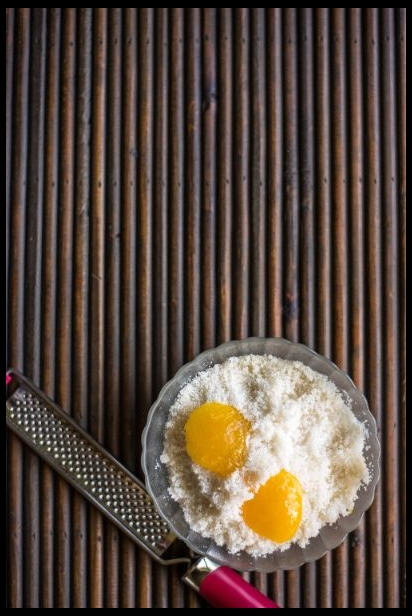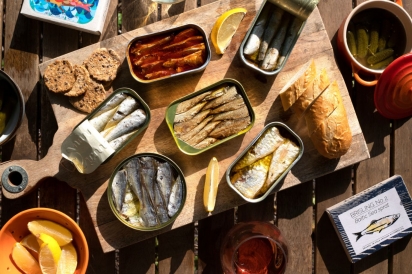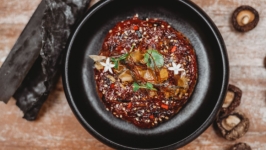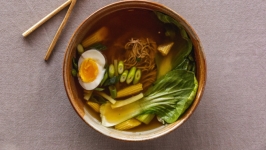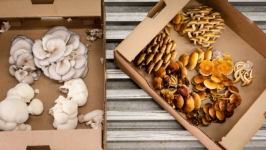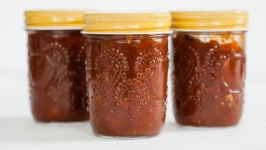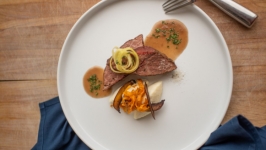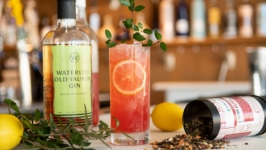What is Umami?
Wolfgang Panicali’s personal interest in cooking began as a means of staying healthy after he stopped playing soccer, but it wasn’t long before it evolved into something more. Encouraged by his friends, he started an Instagram page and a YouTube channel to document his newfound creative outlet. Panicali’s cooking style is heavily influenced by Japanese, Korean and Thai cuisines; he’s fascinated by the ways in which those culinary traditions develop flavor.
“It’s about the amount of flavor relative to the time spent making it,” he says. “With French cooking, you’re simmering stocks for hours on end, then you further reduce those stocks, and that becomes just one component in say, a sauce. As delicious as that may be, your ability to do that sort of cooking at home is largely dependent on how much free time you have. I want to show people how to get as much flavor out of a dish as they can for the time spent making it.”
So, just what exactly is it about Asian food that makes it so easy to develop flavor in a short period of time? Umami, a Japanese word that loosely translates as “the essence of deliciousness.” Also known in the West as savoriness and considered the fifth taste alongside sweetness, saltiness, sourness and bitterness, it is often described as contributing a certain meatiness to dishes, even those in which no actual meat is present.
Umami was first identified in 1908 by Japanese scientist Kikunae Ikeda, who noticed that broth made with kombu, a type of kelp widely consumed throughout East Asia, packed a more delicious, savory punch than other broths. Ikeda determined that an amino acid called glutamate was the source of umami flavor, but it was not seriously pursued by the broader scientific community until the 1980s when the Society for Research on Umami Taste was founded and began hosting symposiums aimed at encouraging discussion and expanding scientific knowledge concerning umami. Finally in 2002, almost 100 years after the initial discovery of umami, the specific flavor receptors responsible for perceiving the taste were isolated on the mammalian tongue. Lately, studies have focused on the potential health benefits of umami, including its ability to encourage the consumption of more nutritious foods by enhancing their flavor as well as stimulating the appetites of elderly patients whose medication can cause loss of taste and reduced salivary activity.
In Asian cuisine umami most often comes in the form of long-fermented sauces and pastes like soy sauce, fish sauce and miso. Because all the hard work and time to develop that umami character is done up front, it adds instant (and intense) flavor to marinades and sauces and even helps balance flavor once the dish is cooked. As Panicali points out, long fermentations often require significant levels of salt to help preserve them, so you need to account for that early on in your food preparation. He recommends tasting the fermented sauces on their own before applying too liberally.
No discussion of umami would be complete without addressing the proverbial elephant in the room – monosodium glutamate, or MSG. MSG is essentially pure umami. It occurs naturally as the white powdery substance that forms on the surface of kombu and is also found in certain cheeses, meats, vegetables and tomatoes. Like umami itself, MSG was first isolated and named by Kikunae Ikeda, who cofounded the company Ajinomoto in 1909 to sell it as a commercial product.
By itself, MSG doesn’t taste like anything. Lick that sheet of kombu all you want, it’s not going to do anything for you. What it does do, however, is activate those umami taste receptors on your tongue when you combine it with food, making each and every bite even more savory and delicious.
Yet somehow, this naturally occurring substance caught a bad rap. Once upon a time in 1968, Dr. Robert Ho Man Kwok reported not feeling all that well after eating at a Chinese restaurant. He attributed his stomach ache to either MSG, sodium or alcohol, but did no controlled experiments before describing the experience in a letter to The New England Journal of Medicine. This letter about “Chinese restaurant syndrome” sparked a decades-long war of racist misinformation directed at Asian-Americans and their cuisine, and led to the popular conception that MSG had negative effects.
Proper studies have found no direct link between MSG and adverse effects on the health. If anything, it makes the potential health benefits of umami in foods more accessible. Yet MSG still suffers from the damage done to its reputation, even in modern food education. “One of my chefs in culinary school was a product of someone from that era so he was really against it,” says Sean White, Chef de Cuisine at Black Sheep Restaurant. And so was White, until he asked a friend who cooked at a Chinese restaurant what secret ingredient he was using to make his food taste so good. The answer, of course, was MSG.
“I started doing research and learned that it’s something that occurs naturally,” says White. “Now I use it on everything.” Everything, including the rub on the Chipotle Blueberry Ribs he developed for the restaurant.
White’s personal style of cooking is a blend of Southern and Latin flavors, a direct result of growing up in South Florida where he learned to cook by his grandmother’s side. While the term “umami” is not one commonly used in either culinary tradition, its presence is just as fundamental to the way each develops its unique flavors. Southern cooking abounds with umami boosters, from tomato-based barbecue sauces to gravies to Worcestershire sauce to the inclusion of bacon in just about everything imaginable. In Latin cooking, the concept of sazón describes a cook’s ability to balance flavor. It’s also the name of a popular seasoning blend that often contains, you guessed it, MSG. Other umami-rich ingredients in Latin cooking include tomato-based salsas, dried chiles, crumbly cheeses and pork.
No matter where you find yourself in this wide world, you can be certain that the local cuisine features some form of umami. In Italy, it comes from Parmesan cheese, cured meats and tomatoes. Bacalao, or dried cod, brings an intense savoriness to many Brazilian dishes. The Australian tradition of spreading marmite, a dark, gooey yeast extract, on toast may seem moderately offensive to our palettes, but it’s a powerful source of umami. The word umami may be a relatively modern invention, but the inclusion of ingredients that make food as irresistibly savory and delicious as possible is nothing new. Now we just know what to call it



